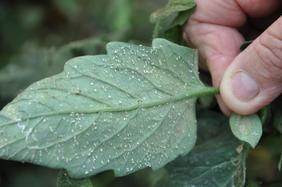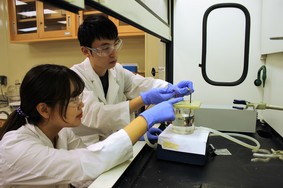|
Having trouble viewing this email? View it as a Web page.

|
|
|
Fresh from the Field is a weekly album showcasing transformative impacts made by grantees supported by the National Institute of Food and Agriculture.
Oct. 19, 2017
|
|
Success Stories

Crab Shells Could Greatly Reduce Pollution
An inexpensive biomaterial
that may be used to sustainably replace plastic barrier coatings in packaging
has been developed by Pennsylvania State University (Penn State)
researchers, who predict its adoption would greatly reduce pollution.
The completely biodegradable
material is comprised of nearly equal parts of treated cellulose pulp from wood
or cotton, and chitosan, the primary ingredient in the exoskeletons of crabs,
lobsters, and shrimp.
According to Penn State
scientist, Jeffrey Catchmark: “These environmentally friendly barrier coatings
have numerous applications ranging from water-resistant paper to food coatings
to seal in freshness. The potential reduction of pollution is immense if these
barrier coatings replace millions of tons of petroleum-based plastic associated
with food packaging used every year in the United States.”
NIFA supports the research
through the Agriculture
and Food Research Initiative, and the Hatch Act funding.
Read the full
story at Penn State. Image provided by Penn State.
|
 Rose Disease Is Not Sweet
Scientists at Texas
A&M University (TAMU), USDA’s Agricultural Research Service
USDA-ARS), University of Arkansas (UK) and other research
institutions are investigating a deadly rose disease called Rose Rosetta
Disease. According to David Byrne at TAMU, Rose Rosetta Disease was
first observed on wild roses as early as the 1940s, but it was not until 2011
that scientists definitively identified the cause as being from a new virus in
the novel genus Emaravirus transmitted by the microscopic eriophyid mite.
Today, the virus is killing commercial rose varieties and wild roses.
Symptoms, which can show up
as early as 17 days from exposure to infected mites or as many as 279 days
after include excessive thorniness, malformed leaves and flowers. Ultimately, all
rose plants are vulnerable to the disease and massive monitoring efforts are
needed.
“The field trials planted the
first year are just now providing data that could lead to developing resistant
varieties. We’re up to about 500 different roses planted for evaluation, and
previous varieties thought to be resistant are turning out to be susceptible.”
NIFA supports the research
through the Specialty Crop Research Initiative.
Read the full story at AgriLife Today. Image provided by Kathleen Phillips-TAMU.
|
News Coverage

Predatory Insect May Help With Whitefly Control
Scientists at the University
of Florida (UF) have found an insect predator that may help greenhouse
tomato growers manage populations of the sweet potato whitefly when used as
part of an integrated pest management system (IPM).
UF scientist Hugh Smith, with a NIFA
IPM Enhancement Grant, observed the feeding habits of the whitefly
predator Dicyphus hesperus to see how effective it would be at controlling
whitefly in greenhouses. He also evaluated its activity in conjunction with
biopesticides commonly used on whitefly in greenhouse tomatoes.
Bemisia tabaci, also known
as the sweetpotato whitefly or silverleaf whitefly, attacks a range of plants,
including sweet potato, squash, tomato and poinsettia. The biotype B species
has been established in the United States since the late 1980s. It
transmits tomato yellow leaf curl virus (TYLCV). Young tomato plants
infected with TYLCV are stunted and unproductive.
Greenhouse tomato growers try to grow as sustainably as possible to compete in a crowded tomato
market. Avoiding synthetic insecticides often gives their crop an edge over
field-grown tomatoes, so many growers turn first to biological control.
Read more at IPM
in the South.
Image provided by Hugh Smith-UF.
|
The Library

Nano-Engineered Surface Guards Against Biofouling
Microbes colonize every
natural or artificial surface on Earth. In some cases, these microbial
communities (known as “biofilms”) can be benign. However, most biofilms are
undesirable: they corrode surfaces (from teeth to oil pipes), and serve as a
refuge for pathogens. Learning to prevent or disrupt biofilms, and thus
minimize their undesirable impacts, remains one of the goals of industrial
microbiology.
NIFA-funded researchers at
the University of Hawaii at Manoa (UH) and their colleagues are a step
closer to reaching this goal. They learned that nano-engineered aluminum discourages
microbes (including pathogens) from settling on surfaces and biofouling them.
To build such a “nano-patterned” surface, the scientists first treated aluminum
with oxalic acid to create nanopillars or nanopores, then etched them with
phosphoric acid, and coated the structure with a nano-thick layer of Teflon.
The scientists were also able to impregnate oils into the nanopores to make
surfaces slippery. These self-cleanable nano-features were effective in
dissuading microbes from settling in. This reduced microbial settlement by up
to 99 percent.
NIFA supports this
research through the Agriculture and Food and Research Initiative.
Read the ACS
Applied Materials & Interfaces article. Image
provided by Soojin Jun-UH.
|
Video
 Youth Learn Ag in the Classroom
The National Agricultural Literacy Curriculum Matrix is
an approach to promote agricultural literacy among K-12 students. The Matrix,
managed by Utah State University (USU) extension and part of the National Agriculture
in the Classroom’s (NAITC) program, is an online collection of educational
resources that are relevant, engaging, and designed to meet the educational
requirements and agricultural literacy outcomes for formal educators. The
Matrix also serves the needs of NAITC programs within each state by providing a
system where teachers can find quality materials that meet educational
standards. The site, available 24-hours-a-day worldwide, supports teachers
regardless of state program, funding, or size.
Watch the USU video to get egg-cited about Ag in the Classroom.
Image provided by Lance Cheung-USDA.
|
Tweet of the Week
#NIFAIMPACTS
|
|

NIFA’s mission is to invest in and advance agricultural research, education, and extension that solve societal challenges. NIFA’s investments in transformative science directly support the long-term prosperity and global preeminence of U.S. agriculture. To learn more about NIFA’s impact on agricultural sciences, visit www.nifa.usda.gov/Impacts, sign up for email updates or follow us on Twitter @USDA_NIFA, #NIFAImpacts.
###
USDA is an equal opportunity lender, provider, and employer.
Editor: Falita Liles
|
|